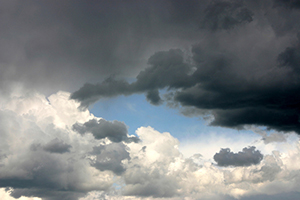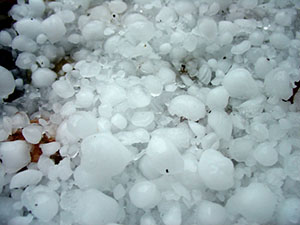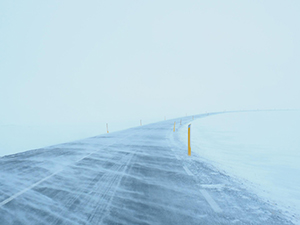SEVERE WEATHER PREPAREDNESS
Seasonal changes bring about different challenges to staying safe. It's never too soon to prepare for severe weather. Start by creating a Preparedness Kit. Severe storms strike quickly. Thunderstorms can produce heavy rain, strong winds, lightning, hail and tornadoes. Winter storms can cause reduced visibility on the road, power outages, and loss of life. Deligently preparing yourself to respond promptly to these threats posed by a storm in your area can help keep ypu and your loved ones safe.
The National Weather Service, in cooperation with the broadcast media and your local spotter system, will provide you with the warnings you need to quickly respond. If you listen to the media, you'll know when a storm is approaching your area and if you need to take protective action.
NOAA Weather Radios are the best warning system for all kinds of emergencies, including severe storms. These inexpensive devices are recommended as the primary warning system for everyone.
Don't wait until an emergency siren sounds to start looking for flashlights and other things. Make sure the entire family knows where to go at home, at work, in school, at the mall or anywhere they might be when the storms strike. Know where you will take shelter.
There are six National Weather Service Offices that monitor the State of Nebraska.
QUICK LINKS
Ready.gov
Be Ready Nebraska
Weather Safety Tips - NWS
Emergency Preparedness - Red Cross
Spring & Summer Resources
Spring & Summer Preparedness
Thunderstorms & Lightning - Ready.gov
Tornadoes - Ready.gov
Winter Weather Resources
Winter Weather Preparedness
Learning About Winter Weather - NWS
SPRING AND SUMMER SEVERE WEATHER PREPAREDNESS
Thunderstorms
 Severe Thunderstorm Watch: Be Prepared! Severe thunderstorms are possible in and near the watch area. Stay informed and be ready to act if a severe thunderstorm warning is issued. Watches are issued by the Storm Prediction Center for counties where severe thunderstorms may occur. The watch area is typically large, covering numerous counties or even states.
Severe Thunderstorm Watch: Be Prepared! Severe thunderstorms are possible in and near the watch area. Stay informed and be ready to act if a severe thunderstorm warning is issued. Watches are issued by the Storm Prediction Center for counties where severe thunderstorms may occur. The watch area is typically large, covering numerous counties or even states.
Severe Thunderstorm Warning: Take Action! Severe weather has been reported by spotters or indicated by radar. Warnings indicate imminent danger to life and property. Take shelter in a substantial building. Get out of mobile homes that can blow over in high winds.
Lightning

- Lightning kills between 75 and 100 people nationwide annually.
- During thunderstorms, stay inside. If you are outdoors, an automobile is a safe place to be.
- Indoors, keep away from doors, windows, stoves, sinks, metal pipes or other conductors. Don't use the telephone. Disconnect electrical appliances such as TVs and radios.
- Outdoors, minimize your height but don't lie flat. Do not take shelter under a tree. Stay away from wire fences or other metallic conductors. Avoid standing in small sheds in open areas.
Hail
Hailstorms don’t last long, but they can create a lot of damage in a short time. Every year, hail causes nearly $1 billion in damages, mostly to roofs and cars.
Before a Hailstorm
 Know What Your Insurance Covers and How Much You Need
Know What Your Insurance Covers and How Much You Need
- Check your insurance policy to see what’s covered and the deductible you’ve chosen.
- Your insurance policy typically covers the cost to repair roofs and cars, and other common hail damage.
- You may have a higher deductible for wind and hail damage than you do for other types of claims. Talk to your insurance agent to find out about your coverage.
How to Reduce Hail Damage
If you haven’t taken a look at your roof in a while, now’s the time. Roof repairs today can help you avoid extensive, time-consuming cleanup later.
- Repair or replace worn, curled or missing shingles.
- If your roof is aging, consider replacing it before hail season begins.
During a Hailstorm
Protext Yourself and Your Car
In severe storms, a hail stone can be as big as a softball and fall at 50 to 100 miles per hour.
- Stay indoors.
- Stay away from skylights and glass doors to avoid broken glass.
- If it is safe, close drapes, blinds or shades to prevent debris from blowing inside.
- If you can, park your car in the garage or other covered area.
After a Hailstorm
If you have experienced damage from a hailstorm, report it to your insurance company as soon as possible.
WINTER SEVERE WEATHER PREPAREDNESS
Winter Readiness for Individuals & Families
 Before the watches and warnings are issued, prepare a winter storm plan that will enable you and your family to survive for up to 72 hours without any outside assistance.
Before the watches and warnings are issued, prepare a winter storm plan that will enable you and your family to survive for up to 72 hours without any outside assistance.
- Have extra blankets on hand.
- Ensure that each member of your household has a warm coat, gloves and mittens, hat and water-resistant boots.
- Make sure all family members know what to do when a winter storm watch or warning is issued.
Assemble A Disaster Supplies Kit For Your Home Containing:
- Flashlight and extra batteries
- Portable, battery-operated NOAA Weather Radio and AM/FM radio; and extra batteries
- First aid kit
- One-week supply of food (include items that do not require refrigeration or cooking in case of power loss)
- Nonelectric can opener
- Bottled water
- One-week supply of essential prescription medications
- Extra blankets and sleeping bags
- Fire extinguisher (A-B-C type)
Develop an emergency communications plan. In case family members are separated from one another during a winter storm ( a real possibility during the day when adults are at work and children are at school), have a plan for getting back together.
Ask an out-of-state relative or friend to serve as the "family contact." After a disaster, it's often easier to call long distance. Make sure all family members know the name, address and phone number of the contact person.
Make sure all family members know how to respond after a severe winter storm. Teach children how and when to call 9-1-1, police or fire department and which radio station to tune to for emergency information.
If You Must Be Outdoors During Winter Weather Conditions:
- Dress warmly. Wear loose-fitting, layered, light-weight clothing. Layers can be removed to prevent perspiration and chill. Outer garments should be tightly woven and water repellent. Mittens are warmer than gloves and are recommended.
- Stretch before you go out. If you go out to shovel snow, do a few stretching exercises to warm up your body. Also take frequent breaks. Those with heart problems or if lead a sedentary lifestyle, be careful of over exertion and heart attack. Be aware of the symptoms of dehydration.
- Cover your mouth. Protect your lungs from extremely cold air by covering your mouth.
- Watch for signs of frostbite and hypothermia.
- Keep dry. Change wet clothing frequently to prevent loss of body heat. Wet clothing loses all of its insulating value and transmits heat rapidly.
- Remember to help your neighbors who may require special assistance-infants, elderly and people with disabilities.
NEMA urges everyone to purchase a NOAA weather radio. Program the device to your county and get the latest information from the National Weather Service--the same information that Emergency Managers receive!
Winter Readiness for Your Home
A major winter storm can be lethal. Preparing your home for cold weather conditions and responding to them effectively can reduce the dangers caused by winter storms.
- Service snow removal equipment and have rock salt on hand to melt ice on walkways and kitty litter to generate temporary traction.
- Make sure you have sufficient heating fuel; regular fuel sources may be cut off.
- Winterize your home:
- Insulate walls and attic.
- Caulk and weather-strip doors and windows.
- Install storm windows or cover windows with plastic from the inside.
- Have safe emergency heating equipment available.
- Fireplace with ample supply of wood.
- Small, well-vented, wood, coal or camp stove with fuel.
- Portable space heaters or kerosene hears (See kerosene heaters below).
- Install and check smoke detectors.
- Keep pipes from freezing.
- Wrap pipes insulation or layers of old newspapers.
- Cover the newspapers with plastic to keep out moisture.
- Let faucets drip a little to avoid freezing.
- Know how to shut off water valves.
During A Winter Weather Event:
- Stay indoors and dress warmly.
- Conserve fuel. Lower the thermostat to 65 degrees during the day and 55 degrees at night. Close off unused rooms.
- If the pipes freeze, remove any insulation or layers of newspapers and wrap pipes in rags. Completely open all faucets and pour hot water over the pipes, starting where they were most exposed to the cold (or where the cold was most likely to penetrate).
- Listen to the radio or television to get the latest information.
Winter Readiness for Your Automobile
If you plan to travel during the winter, the Nebraska Emergency Management Agency (NEMA) and the National Weather Service recommend you stay abreast of local weather reports. When the forecasters are predicting threatening weather, the best bet is to seek shelter and wait out the storm.
The Nebraska Department of Roads provides up to the minute road conditions at Nebraska 511. Knowing the road conditions can mean the difference between arriving on-time or not arriving at all.
Those who travel even during the worst of times are advised to carry a winter storm supply kit in their vehicle. Assemble a separate disaster supplies kit for the trunk of each car used by members of your family that includes:
- Blankets or sleeping bag
- Extra sets of dry clothing
- A windshield scraper
- A shovel
- A container of sand
- Tire chains
- Battery booster ("jumper") cables
- A tow chain or rope
- First aid kit
- Flashlight or emergency light with extra batteries
- Transistor radio with extra batteries
- A brightly colored cloth
- Candles
- High calorie and nonperishable food
Another item that might make the difference is a cell phone. If you are stranded in your car during a blizzard, make a call and wait for help to arrive. Do not try to walk to safety.
Avoid Traveling By Car In A Winter Storm, But If You Must Travel
- Have emergency supplies in the trunk.
- Keep your car's gas tank full for emergency use and to keep the fuel lines from freezing.
- Travel during daylight and let someone know your destination and route. Try to travel with other vehicles.
Survival Tips: Frostbite & Hypothermia
Frostbite is a severe reaction to cold exposure than can permanently damage its victims. A loss of feeling and a white or pale appearance in fingers, toes or nose and ear lobes are symptoms of frostbite.
Hypothermia is a condition brought on when the body temperature drops to less than 90 degrees Fahrenheit. Symptoms of hypothermia include uncontrollable shivering, slow speech, memory lapses, frequent stumbling, drowsiness and exhaustion.
If frostbite or hypothermia are suspected, begin warming the person slowly and seek immediate medical assistance. Warm the person's trunk first. Use your own body heat to help. Arms and legs should be warmed last because stimulation of the limbs can drive cold blood toward the heart and lead to heart failure. Put person in dry clothing and wrap their entire body in a blanket.
Never give a frostbite or hypothermia victim something with caffeine or alcohol.